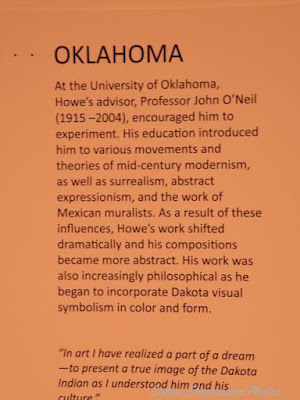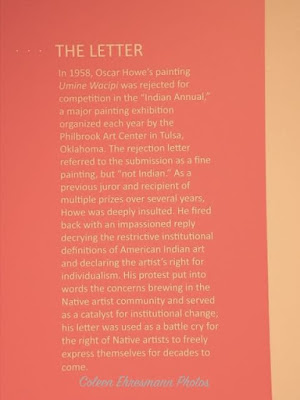In the blog post Murals in Mobridge, July 26th, I posted about my visit to Mobridge SD to see murals painted by South Dakota Native artist, Oscar Howe. (click on the link to refer to that blog post) Howe painted the murals in the early 1940s. (Oscar Howe 1915-1983)
I stopped at the South Dakota State Art Museum to see the display of Howe's artwork, from his high school days to his later years in the 1960s. The display showcased a couple of his famous works of art.
In 1938, he graduated from Santa Fe Indian School where he was taught by Dorothy Dunn, who encouraged her students to use their Indian culture to inspire their artwork.
Howe began his most enduring public art project in 1948 as the designer of the Corn Palace murals in Mitchell, South Dakota. "I have waited so long for this job, now I shall have my big chance," Howe wrote at the time. Though he said it was not "looked upon as an art achievement," the visibility of this local attraction was meaningful to Howe; he had longed for it for at least a decade. The temporary murals, constructed with three colors of corn, became a platform for Howe to reach an audience of everyday people from many walks of life. His depictions of the annual themes had wide popular appeal but also emphasized the shared values and connections between the Native and non-Native peoples of South Dakota. He designed the murals until 1971.
By the 1960s, Howe no longer used conventional perspective in painting the Sun Dance; the viewpoint is that of a participant, looking up from below. The dancers have completely lost their earthly connection as their bodies dissolve into swirls of ecstasy. The pole is viewed at an acute angle, and it, too, appears to sway and bend as the rules of physics slip away.
Despite the abstract turn in Howe's mid-career work, most of Howe's paintings remain figurative. His foundation for a range of experimentation in form was a point-and-line composition technique:
after contemplating an empty sheet of paper, as his artistic forebearers had examined a prepared animal hide, he established several points of interest from which he built his complex line drawings.
His planned subject emerged from these points on the page as he added flat planes and facets.
In some paintings, the figure is easily identified. In others, shapes and lines take on a life of their own: black hair becomes dramatic spikes, dancers are subsumed by spinning swirls of color, and a horse and rider become indistinct, interconnected shapes.
Cunka Wakan (Dakota Horse), 1966
Buffalo Dance, 1955
Breaking a Wild Horse, 1967
Known to his people as Mazuha Hokshina, or Trader Boy, Howe, elevated himself from illness, poverty and prejudice, to a position of international admiration and respect as an artist and teacher.
It was very interesting to see the change in artistic style during his career. Dakota Modern: The Work of Oscar Howe is on display at the South Dakota State Museum in Brookings through September 17, 2023. Admission is free. Parking is across the street from the museum. The display is on the first floor.







.jpeg)



No comments:
Post a Comment
Thanks for your comments!